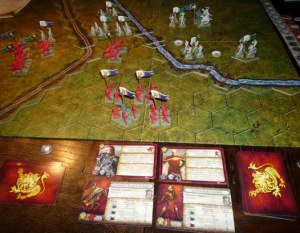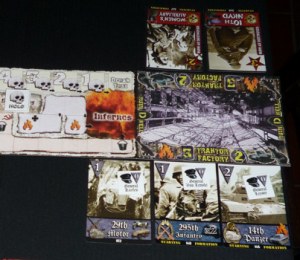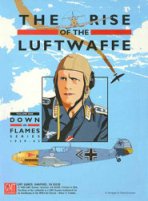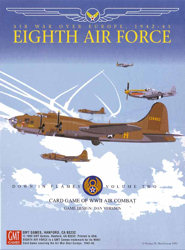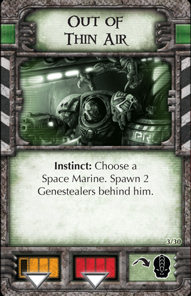
"Operation Red Nose" - 4 days of eating, drinking, and non-stop gaming!
This years’ HFC & Friends Game Meeting was again held around the days that are known in Germany as ‘Karneval’ or ‘Fasnacht’ and which is a time when folks start wearing silly costumes, drinking a lot and dancing to a very weird form of music 😉
Since we don’t belong to those who take part in such strange rites, we usually use the time to prepare ourselves with beer, food, and games and then just close the door for a few days of gaming. A good friend of ours, Wolfgang, who is living in Mainz (also a city which is ruled by the ‘fools’ during this time) then comes over to join us and so he arrived on Friday, quite early. Denny and I got some new cool games over the year which he didn’t know yet, and we were also eager to get some multiplayer games going with games we could only play with two players so far, so we were looking forward to some great game sessions.
When Wolfgang arrived, we started with a little chitchat and had a beer for starters and then we prepared the gaming table. He was very interested in trying out some LCGs about which we talked before and he had some first impressions about the core gameplay of these sort of card games when he played Magic the Gathering: Duels of the Planeswalkers on the Xbox 360 (it’s not a LCG, but not actually a CCG either, so it’s a game in-between with pre-built decks and limited possibilities to customize your deck). But he at least knew the basic gameplay and he liked it, so he was interested to see how a real LCG would be played face to face.
Call of Cthulhu (LCG)
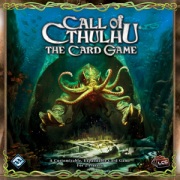
The first game: Call of Cthulhu (LCG)
The first game on the table was Call of Cthulhu (FFG), which is the easiest of the three LCGs published by FFG so far. Since we all love Arkham Horror and the Lovecraft theme, this game seemed to be a good introduction to the LCG genre. We set it up, I explained the basic Sequence of Play and then we started playing right away, using the player aid sheet that we had printed out and laminated before, to make things as easy as possible.
Wolfgang chose the Miskatonic University deck and I played a Shub-Niggurath deck, all of which were mono decks. By now, we own enough Asylum Packs to play all factions of the game as mono decks, and although for some players out there this doesn’t seem to be the best way to play the game competitively, we decided to use mono for Wolfgang’s introductory games for several reasons. First, it’s easier for a new player to see how a faction in a pure format is played, how it feels, and he will soon realize the strengths and the weak points of that faction. To know the specific strengths and weaknesses of a given faction is an important prerequisite for deck customization.To give Wolfgang a very harsh and brutal impression of each fashion, we even removed the neutral cards from all decks, so that he could feel the raw characteristics of each faction without any fine tuning and balancing. The intention was to show him the options for deckbuilding and deck enhancements by chosing a certain focus, adding neutral cards, or even by building a combi deck with a second faction, which will eventually lead to a deck that works great. If you don’t know the characteristics of a certain faction, you don’t really know how to counter their weaknesses or how to maximize their strong aspects.

CoC gaming table
Apart from this, we generally don’t mix all factions wildly together because we love to play the game based more on theme than on raw competition power, so Denny and I also chose our decks based on the humans vs cultists dichotomy that is part of the Lovecraft stories. Denny is playing all cultist/Old Ones factions while I am playing the Syndicate, Miskatonic University and the Agency. In our games, we pimp these factions with neutral cards but seldom mix them with the other factions, it just feels right for us to actually play from a certain story perspective.
The first game indeed showed that the Miskatonic University (with all their professors and students, who are well-educated and learned in old scriptures dealing with arcane content) is a difficult faction to play without any neutral cards. The MU is quite strong in the arcane and investigation struggles, but really weak in terror and combat. That means if you are sending out some of these academics to investigate what’s happening, they might have the knowledge to solve the arcane and investigation struggles but they are easily frightened by anything supernatural. So before they can use their strengths to get some success tokens on a story, they often will flee the scene because of a lost terror struggle or be dead and out of the game after an attack by the monsters lurking around.

Shubb-Niggurath vs. Miskatonic University
Shub-Niggurath, on the other hand, is quite strong in terror and combat, but lacks on the investigation side, so usually this deck doesn’t score a point in the investigation struggle, even if no one is around to stand against them. Therefore, bringing success tokens on the story is taking some time and the fastest way to achieve this is by eliminating the opponent’s characters with terror and combat, so at least you get the additional success token for being unchallenged in a story. The match MU vs. SN seemed to be a bad choice at first and very unbalanced as the first game was a complete domination of my Shub-Nigurrath faction over the MU, who never really got thru because of losing the first two struggles (terror and combat). Afterwards, we decided to play a second game with the same factions nonetheless, because Wolfgang didn’t want to base his judgement about this particular faction on his first game alone, so now feeling a bit more competent and knowing what the MU faction can do – and what not, we shuffled the cards and started again.
This time – and that’s the beauty of the game, really – things went completely different and not really well for me. I wasn’t able to bring out characters in the first turns at all and in later turns only some weak ones while Wolfgang had some great guys on the table, who were able to limit my actions and could control the game by their various character abilities. He hit me fast and hard with some spells, which limited me even further and he actually rushed me and won quite easily this time. Since I couldn’t send out some of my better characters to challenge him, he had not to deal with the terror and combat struggles as much as in our first game. Some of his abilities changed all terror or combat struggles into ones that could only be won with investigation icons and since that’s not the strength of Shub-Niggurath, I usually lost these as well as the genuine investigation struggles. So the second game ended with an easy victory for the MU and it was a good example how even such an unbalanced combination of factions in a game can be won by the faction that is considered the weaker one if things go right for them.
Still, the MU usually has a hard time alone and makes for a much better support faction in a combi deck, so a strong partner who can deal with terror and combat is able to cover their backs, while they can use their arcane and investigation icons to keep standing after being involved in a story and collect success tokens on a regular base.
Generally, Wolfgang liked the game and stated “that it demonstrates very well the strong aspect of LCGs – very simple game mechanics, but still lots of tactical/strategic options and the possibility to play it according to your very own ideas with the customization of the decks”. This ‘easy to learn, hard to master’ nature of the game appealed to him and so he said: “Let’s try out another LCG!”.
Warhammer Invasion (LCG)
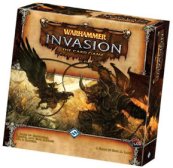
The next game: Warhammer Invasion (LCG)
So we prepared the gaming table for the next LCG, one step up in complexity and options (complexity is a relative term here, of course, because compared with a consim, all LCGs are quite simple) and that was Warhammer: Invasion.
Warhammer: Invasion is based on the Warhammer Fantasy universe, a different universe than the known Warhammer 40k universe, and we only own the core set so far. Thus, when using only the core set, you simply choose your faction from the pre-built decks in the box, spice up this basic deck with 10 random neutral cards and you are ready to go. Wolfgang stuck to a human faction as he did in the previous game, so he chose the Empire. As in CoC, Denny and I had divided the factions among us – she’s playing the Orcs, the Chaos etc. and I’m going into battle with the Dwarfs and the Empire. I didn’t have any problems with Wolfgang’s choice because this would allow me to play a faction which was completely new to me as well. I wanted to try out the Chaos, so after choosing sides and dealing out the neutral cards, we laid out the citadels and the war-horns were blowing…

The Chaos was crushed by the Empire
Using our player aid sheets and the rulebook, we got into the game easily and it didn’t take long before we were engaged with each other, thinking about our possibilities. I had some form of deja vu however, because I couldn’t really bring out many characters. What I had on my hand was expensive and so I had some troubles to defend my citadel while lacking the force to really attack his one. The game went on with some discussions about the rules and the card wordings, which is still a general problem of this whole genre. You are easily disappointed when you come to the game with a consim mind, expecting some clear and extensive rules about all details of the game. One has to adapt to a very literal understanding of the cards’ wording to not get into trouble about how some cards are used and especially when to use them.
In the mid game, I was able to bring out better characters and at least could stand against the fast Empire deck for some time, but in the end I lost. Apparently, you have to get used to the abilities and characters of the Chaos faction if you want to be successful, so we decided to shuffle the decks and used the same cards for a rematch.
This time I had some great cards in my starting hand and was able to bring out some good characters and cards that created corruption to the enemy, while my characters could gain strength thru their corruption! I had some nice little synergies in effect and prepared for some major attack… when the Empire cleared the battlefield with a card that killed all characters in play who were not in a zone with a developement! I didn’t have any developments in play because I planned to use my cards offensively and Wolfgang had only a few characters out and one developement which saved a good character.

As scary as the dark forces of Chaos: The cake, forged by orcs in the depths of Mordor, made of blood and steel
So I saw myself totally open to the enemy with all my good cards and my smart little synergy plan destroyed in one single sweep. Things went bad again for my Chaos faction from then on, I didn’t get any good cards anymore or at least not cards I could afford with my now limited resources and from my citadel I could watch Wolfgang preparing for battle with more and more troops. In the end he had out a dozen cards both for the attack and the defense while I could barely bring out a little demon then and now before everything was killed again and so that game ended also with a glorious victory of the Empire over the Chaos.
This game was even more appealing to him because of the nice touch of options you get with the three zones in play, but the cards and rules questions that came up were a bit disappointing for him. The problem is not so much the fact that a game which uses many different cards and effects and time frames to play cards and defend against cards, has some ambiguous aspects in the wordings of rules and card texts, but the unsatisfying situation that there’s not really any answer to get by the designer(s). When you look for some answers that might help you to clarify specific points, you usually only have the official FAQ and the forum over at FFG or BGG.




